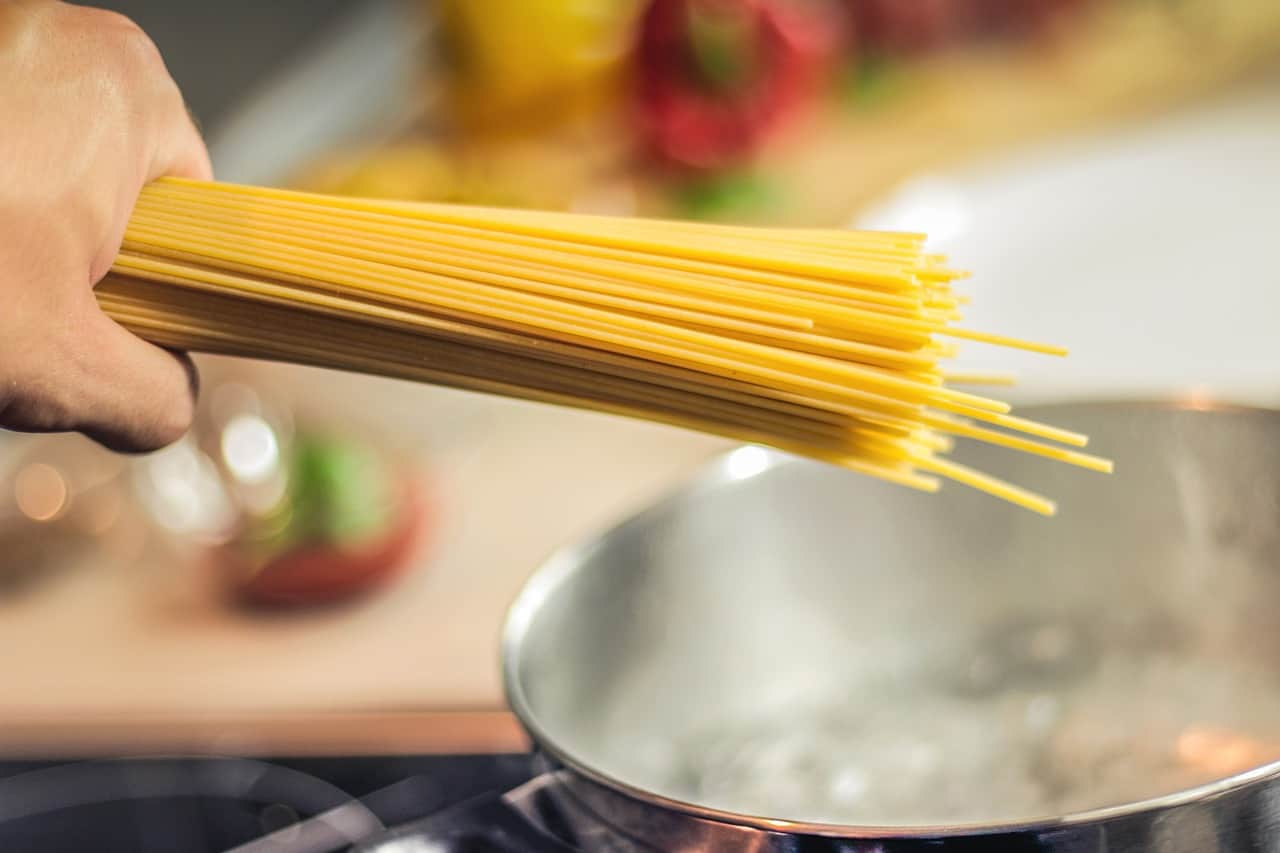Pasta is one of the best weeknight meals for busy people and novice cooks alike. Pasta can easily be cooked using a wide range of kitchen appliances, including an induction cooktop.
Pasta can be cooked on an induction cooktop in induction compatible pots and pans. You can either use a saucepan to cook macaroni or a large pasta pot to cook spaghetti. Water for pasta boils faster than on a regular cooktop, but regardless, the time to cook pasta is the same on every cooktop induction, electric or gas.
Is induction cooking hard to learn for pasta?
If it’s your first time using an induction cooktop, don’t worry. These cooktops are fairly easy to learn to use, and aren’t much different than regular stovetops for cooking pasta. The most important thing to remember when using your induction stovetop to cook pasta is to use the appropriate pot. These types of pots include:
- Carbon steel
- Stainless steel
- Cast Iron (smooth bottom, not rough bottom)
- Any saucepan has a magnetic attraction.
LOOKING FOR A GLASS STOVETOP PROTECTION MAT?
@profamilychef♬ NOTHING – Westover
Test out your pasta saucepan by holding a magnet, such as your refrigerator magnet, to the bottom of the pan. If you feel a pull, it means it’ll work on your stovetop! You won’t be stuck waiting for your pasta water to boil. In this case, the adage a watched pot never boils is 100% true.
If your pots are not compatible with induction you can always trick the induction cooktop by using one of these converter discs.

How to use your induction stovetop for cooking pasta
There are two components for any good pasta:
- The sauce
- The pasta noodles
You’ll want to start off by cooking your sauce on the induction stove, since this will take the longest time (depending on the amount of ingredients you have and if it’s homemade). If you’re using a canned tomato or other pasta sauce (ahem, because why not?), you can certainly wait until your pasta noodles are almost al dente to begin heating your sauce in a saucepan.
To use your induction stovetop to cook your pasta sauce:
- Clean the bottom of your saucepan and make sure it is dry.
- Check to see if your saucepan is dented and make sure it is completely flat. This is essential for the induction heating magic to take place!
- Place your pan on the stovetop’s cook zone that is the closest size to your saucepan. Using a saucepan that is too small will prevent the stovetop from detecting your cookware, and a saucepan that’s too large won’t heat effectively.
- Press the on-off button on the cooking zone.
- Adjust the temperature settings for your sauce. Settings will usually range from 1 to 10, with 10 being the highest heat setting. For a pasta sauce, a medium to medium-low heat setting is best when cooking and simmering.
- You will hear a low humming sound as your cookware heats. This is completely normal, and is a sign everything is going to plan!
- Once you’re done simmering your sauce, remove the saucepan from the induction surface and turn off your stove. Some induction cooktops will come with automatic shut off once they detect your pan is no longer on the surface.
Boiling the water for your pasta
Using the steps above, you can easily cook pasta sauce just like on any other stove. For busy workers, moms, and dads, we have good news! Boiling water on an induction stovetop takes only around 4 minutes, unlike other stovetops which take anywhere between 7 to 8 minutes! Make sure you’re ready to go once your water is boiled.
Once the water is boiled, you can add in your pasta noodles and cook them until they are al dente. Remember, induction stovetops are unique in that induction stovetops have even heating all-around. Once you set the temperature, your cookware will stay at this temperature, unlike other stoves which can overcook and increase the temperature of your pasta dishes over time.
This means that you don’t have to keep the heat high when boiling pasta in order to cook it faster. Simply let the water boil, add in your pasta, and turn the heat to medium until it’s al dente! If you boil your water at a high temperature, this means you have a higher chance of evaporating your water before your pasta cooks all the way through. This can be avoided by turning down the heat as your pasta cooks.
To cook pasta on an induction stove:
- Add 1 liter of water (4 cups) for every 100 g or 3.5 oz of pasta to your saucepan with high sides.
- Add salt to your water for seasoning. The Italians say to make your pasta water as salty as the Mediterranean Sea, but from my experience, as salty as about a tablespoon of salt per four cups of water works fine.
- Use the steps we listed above for using your induction stovetop, and wait for your water to boil (it won’t take long).
- Once your water is boiling, place your pasta in the saucepan along with a bit of oil so it won’t stick.
- Wait between 8 to 12 minutes for dried pasta to cook (average cook time is 10 minutes).
- Check to see if your pasta is al dente if it is not mushy or chalky, but is still chewy and firm. It’s best to check individual noodles about 2 minutes before the cooking time your recipe calls for.
- Remove your saucepan from the induction zone and dump your pasta in a strainer and reserve cooking water. The starch from the pasta water will thicken up your sauce.
- Place your cooked pasta noodles in the sauce, or drag them directly from the water to the sauce (whichever directions the recipe calls for).
Conclusion
Pasta is already a go-to for weeknight dinners. Using an induction cooktop cuts your cooking time in half and is fairly easy to use to cook your pasta. Just make sure your saucepan is compatible with your induction stovetop, and take care of the glass surface on your stovetop.
More induction cooktop tips and tricks:
–What do you put under an induction cooktop
–What should you not use on an induction cooktop
–How can i protect my induction or glass stovetop
–Best induction cooktop with downdraft
Cooking on induction cooktop
–How to cook eggs on induction cooktop

